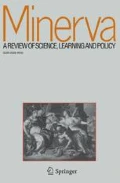Revisionist historians of the nuclear age have long argued that it was not necessary to have used the atomic bombs in August 1945 to bring the Second World War to an end, and that a more conciliatory approach by the Truman administration towards the Soviet Union—being franker with Stalin about the bomb and giving him an assurance that it would not be used—would have created a better chance of achieving a less confrontational postwar relationship between the two powers. They have also challenged the “myth” that the reason for using the bombs was to save American lives.
Similar content being viewed by others
References
AlperovitzGar, Atomic Diplomacy: Hiroshima and Potsdam (New York: Simon and Schuster, 1965 and 1985); and, with others, The Decision to Use the Atomic Bomb and the Architecture of an American Myth (New York: Knopf, 1995).
See the remarkable account of these last days by a group of Japanese historians in The Pacific War Society, The Day Man Lost: Hiroshima, 6 August 1945 (Tokyo: Kodansha International, 1972).
HollowayDavid, The Soviet Union and the Arms Race (New Haven and London: Yale University Press, 2nd edn 1984), p. 15.
MedvedevZhores, Soviet Science (New York: W.W. Norton, 1978), p. 13.
MedvedevZhores, Soviet Science (New York: W.W. Norton, 1978), pp. 20–21.
MedvedevZhores, Soviet Science (New York: W.W. Norton, 1978), p. 37.
WeissbergAlex, Conspiracy of Silence (London: Hamish Hamilton, 1952); preface by Arthur Koestler.
Koestler, in Conspiracy of Silence (London: Hamish Hamilton, 1952); p. x. Koestler was a friend of Weissberg's wife Eva whom Koestler had known since childhood. She was herself, in 1936, incarcerated (in the Lubyanka prison) for 18 months and then expelled from Russia. She was a ceramist by profession and was accused, among other ludicrous charges, of concealing swastika patterns in her tea cups.
Cairncross later worked at Bletchley, where the German “Enigma” code was cracked, and continued to feed the Russians with information. ModinYuri, My Five Cambridge Friends (New York: Farrar, Strauss & Giroux, 1994).
Holloway, David, “Entering the Nuclear Arms Race: The Soviet Decision to Build the Atomic Bomb”, Social Studies of Science, II, 2 (1981), p. 186. The first run of the English original was only 1,000 copies.
RhodesRichard, The Making of the Atomic Bomb (New York: Simon & Schuster, 1986), p. 750.
RhodesRichard, Dark Sun: The Making of the Hydrogen Bomb (New York: Simon & Schuster, 1995), p. 257.
Reported in Pravda, 20 February, 1984; quoted by Holloway, p. 216.
HewlettR.G. and DuncanF., Atomic Shield, 1947–1952: A History of the United States Atomic Energy Commission (University Park and London: Pennsylvania State University Press, 1969), pp. 362–366.
BiewA.M., Kapitsa: The Story of the British Trained Scientist Who Invented tthe Russian Hydrogen Bomb (London: Frederick Muller, 1956).
Tamm was belatedly awarded the Nobel prize for physics in 1958 for his work on electromagnetic radiation.
For two accounts of this plague-ridden mission see Sweeney, Charles, “Three Seconds over Nagasaki”, Toronto Globe and Mail, 29 July, 1995; and Alvarez, Luis W., Adventures of a Physicist (New York: Basic Books, 1987), pp. 145–146.
WeisskopfVictor, The Joy of Insight: Passions of a Physicist (New York: Basic Books, 1991), p. 196.
Sakharov's memoirs; quoted by Holloway, p. 318.
Rights and permissions
About this article
Cite this article
Grove, J.W. Stalin's bomb: Soviet physicists and the Cold War. Minerva 34, 381–392 (1996). https://doi.org/10.1007/BF00127073
Issue Date:
DOI: https://doi.org/10.1007/BF00127073




